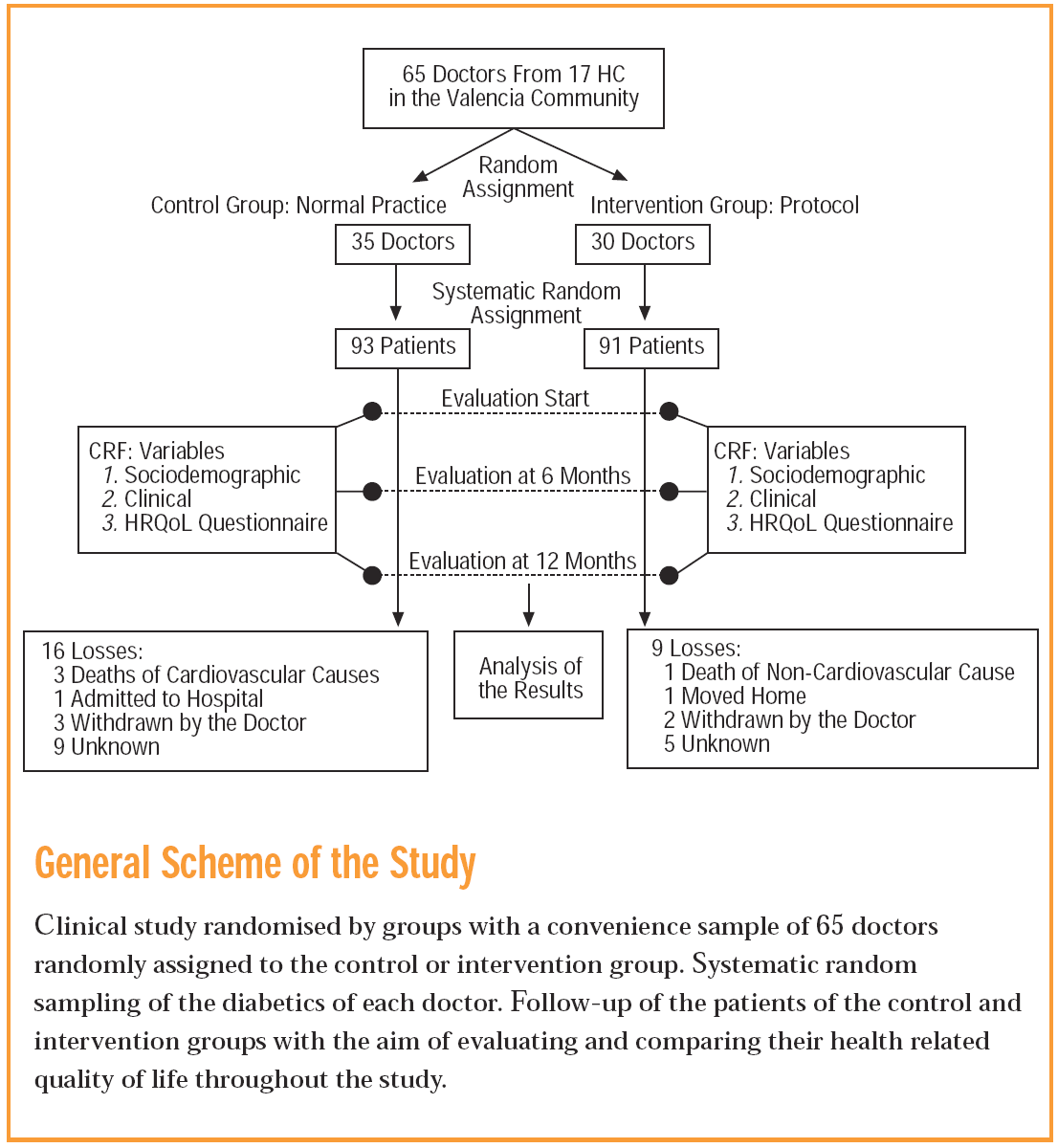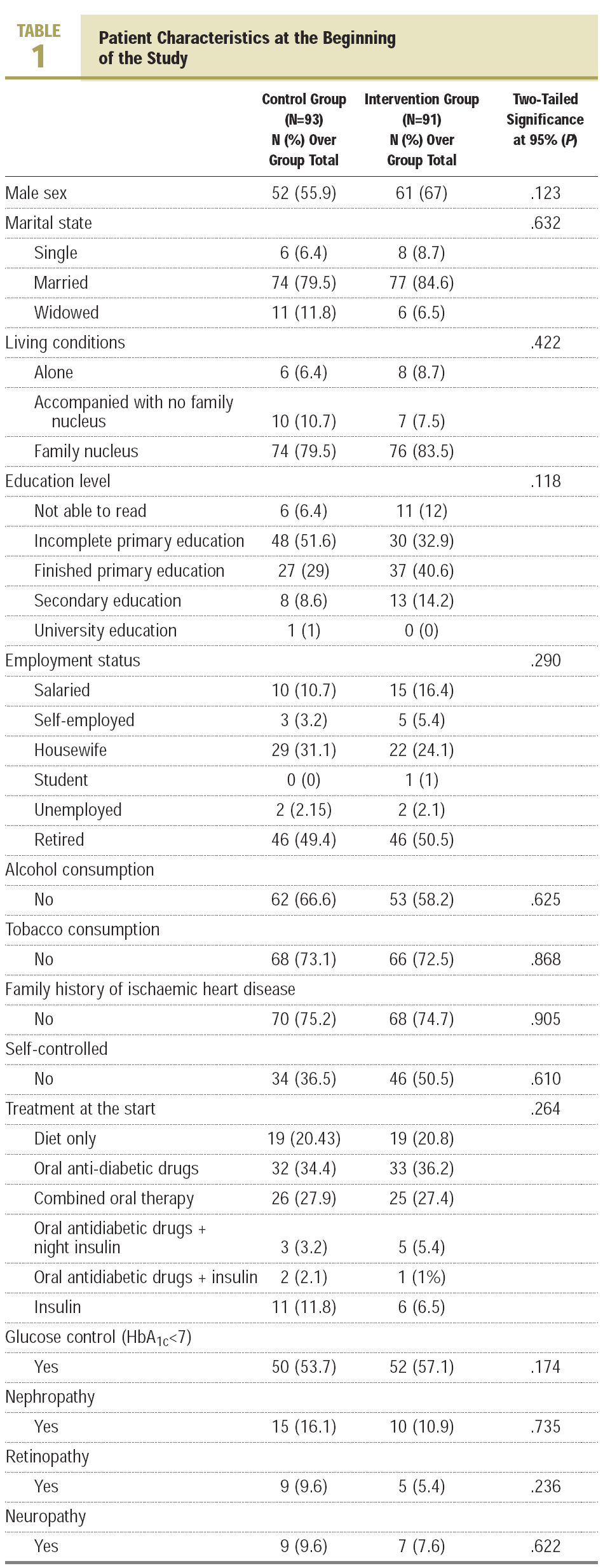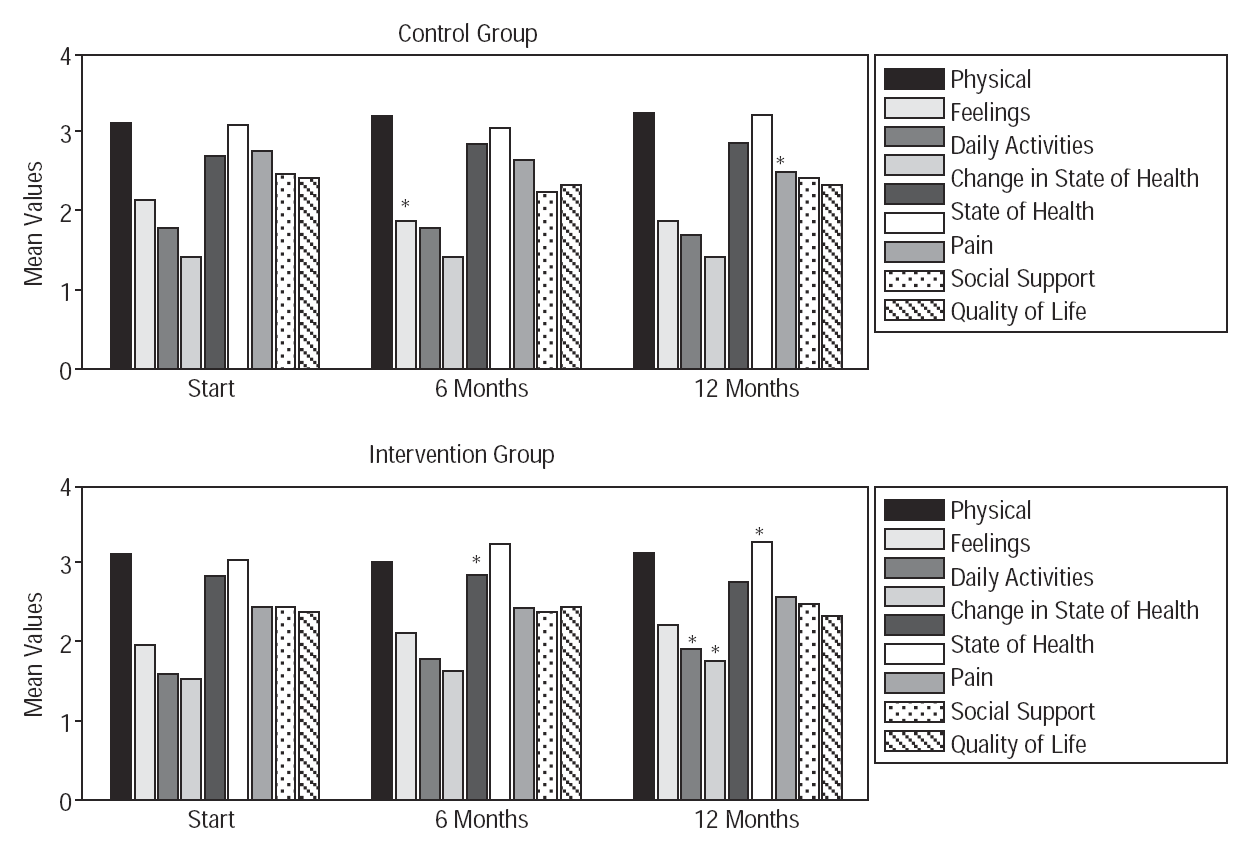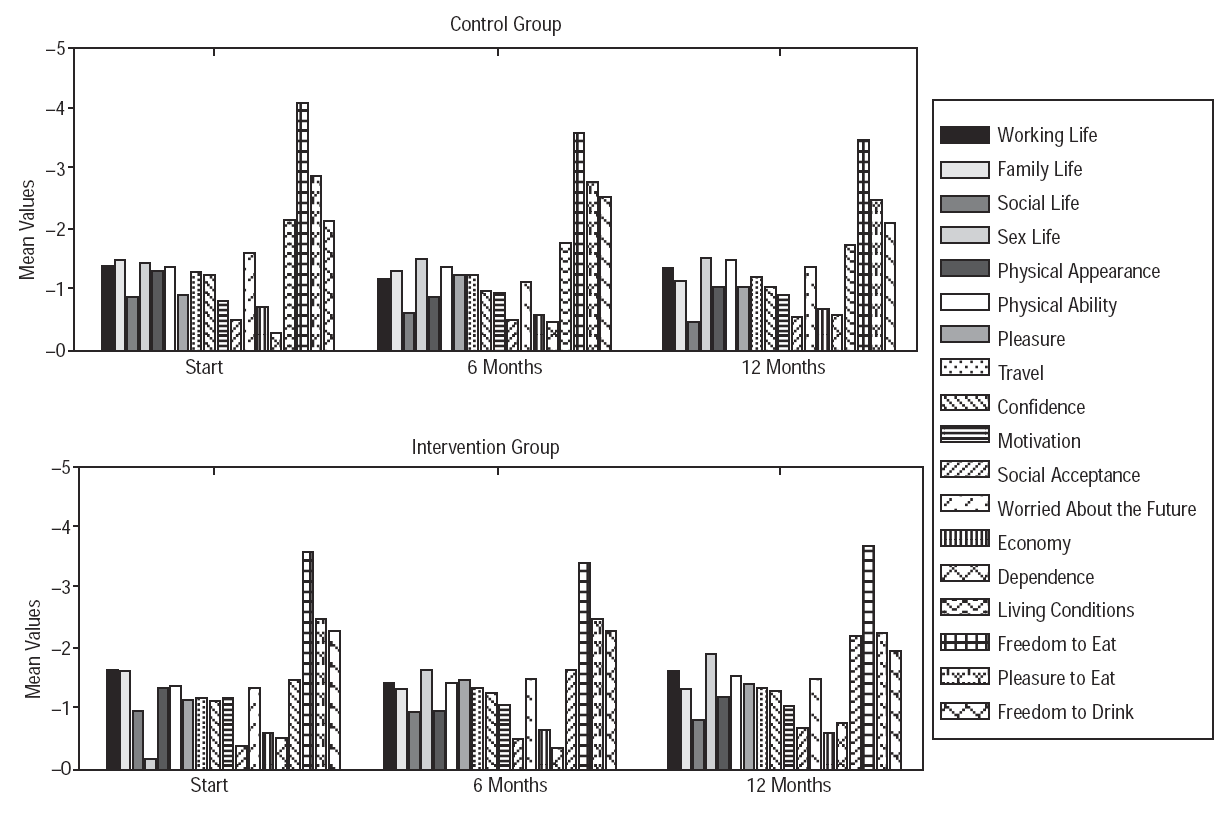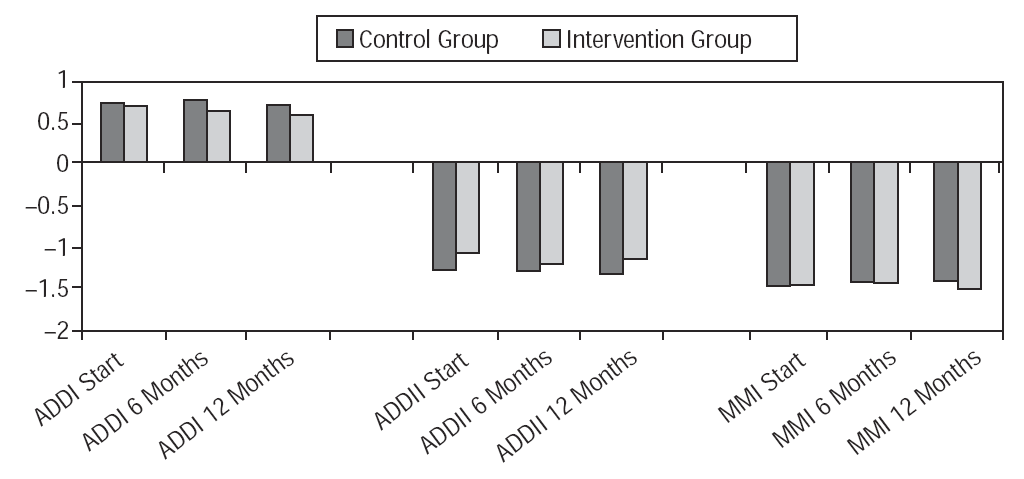Introduction
The ageing population in the developed countries has given rise to a higher prevalence of chronic diseases, such as diabetes mellitus (DM),1 which has an overall impact on the health related quality of life (HRQoL).2 Health policies and health professionals are showing increasing interest in becoming familiar with and improving the HRQoL of these patients, since it not enough just to control the morbidity and mortality variables.3
The control of cardiovascular risk factors (CVRF) reduces the morbidity and mortality in diabetic patients.4-10 However, it is possible that strict diagnostic and therapeutic strategies achieve improvements in some analytical parameters but worsen the overall perception of health of the patient. In the UKPDS11 study it is estimated that the HRQoL in type 2 diabetics is only affected by the complications of the diabetes.12
As primary care (PC) professionals, we should reflect on the sense of applying treatment and diagnostic tests with the aim of improving the intermediate variables results (glycosylated haemoglobin [HbA1c], blood glucose, etc) without knowing the impact on the results of the end variables, such as HRQoL.
The main objective of this study is to measure the HRQoL in diabetic patients with a high cardiovascular risk (CVR), who were subjected to an intensive treatment protocol to control CVRF for 1 year and compare them with a control group followed up according to normal practice by each doctor, thus evaluating the HRQoL in the 2 groups at 6 and 12 months, compared to that at the start of the study.
Methods
Design
Clinical study randomised by groups with a convenience sample of 65 doctors from 17 health centres in the Valenciana Community, with each doctor randomly assigned to the control (CG) or intervention group (IG). Systematic random sampling was carried out on the diabetic patients of each doctor. The patients were followed up by each doctor for 12 months depending on the assigned group: CG (normal practice) and IG (the Valencia Society of Family and Community Medicine Cardiovascular Diseases Working Group intensive treatment protocol to control CVRF).
Study Population
Patients with type 2 DM and high CVR according to the Framingham equation13 were included in the study between February and June 2002. The inclusion criteria were: patients between 45 and 75 years, diagnosed with type 2 DM for more than 2 and less than 20 years and with a CVR greater than 20% at 10 years.
The exclusion criteria were: history of ischaemic heart disease, terminal illness (life expectancy less than 6 months), hepatic cirrhosis, renal failure with creatinine >2 mg/dL, New York Heart Association grade III-IV cardiac failure, and mental disorders that would prevent the completion of the questionnaires.
The patients self-completed the HRQoL questionnaires. Permission was granted by the authors of the questionnaires.
Tools
At the start, 6 months and 1 year, the patients were given the generic questionnaire for measuring HRQoL using COOP/WONCA HRQoL charts.14,15 This questionnaire has 9 sheets, each one of them refers to a dimension of HRQoL, with 5 possible responses, on a Likert type scale of 5 points (higher score, poorer perception of HRQoL),16 a specific questionnaire for diabetic patients, the ADDQoL,17, which measures the impact of diabetes on HRQoL. It has 2 general items (overview): the ADDI, which measures the current HRQoL (3 indicates excellent and 3 extremely bad), and the ADDII, which measures the overall impact of diabetes on the HRQoL (3, indicates a lot worse and 3, a lot better).
Also, the ADDQoL consists of 18 items that assess dimensions associated with physical functionality, psychological well-being, social well-being, personal activities and development. Each item uses a 7 point scale (3 to +3), which is multiplied by the importance that the patient attributes to each item (0-3). Using this product a score from 9 (maximum negative impact) to +9 (maximum positive impact) is obtained in each dimension. This questionnaire enables a final weighted score to be calculated on the effects of diabetes and its treatment on the HRQoL of the patient, the mean measured impact (MMI).
Variables
Sociodemographic and socioeconomic variables, as well as clinical variables, were analysed: CVR, blood pressure, total cholesterol, high density lipoprotein cholesterol (HDL-C), smoking, and alcohol consumption. The COOP/WONCA charts dimensions and the ADDQoL were also evaluated.
Sample Size
The sample size was calculated to detect a standardised mean difference of 0.4 of the main CVR variable with a one tailed hypothesis (alpha, 0.05; power, 0.80), which is 77 diabetics per group which, assuming 20% losses, would be 180 diabetics, 90 per group.
Statistical Analysis
This was performed using the SPSS packet version 12.0. A descriptive analysis was carried out on each of the dimensions evaluated by the COOP-WONCA charts and the ADDQoL in each group. Each category was compared between both groups at the start, 6 months and 12 months by using the Mann-Whitney U non-parametric test. Each dimension within the same group was measured throughout the study using the Wilcoxon test.
Results
A total of 184 patients were included, 93 in the CG and 91 in the IG. The mean age of the CG was 63.57±4.93 years and 62.25±5.26 in the IG. The sociodemographic and medical characteristics at the beginning of the study are shown in Table. A significant reduction in CVR was seen in the IG at 12 months (CVR at start, 36±9.7; CVR at 12 months, 31±11.02; P<.000).
Results of the COOP/WONCA Charts
Both groups followed a similar distribution during the year of the study (Figure 1). The dimensions in which the highest scores were obtained were, physical shape, state of health, and pain, during the whole study.
FIGURE 1 Mean values of COOP-WONCA charts. *Significant differences detected in the groups during the study (P<.05). Wilcoxon test.
On comparing both groups, small significant differences in the feelings dimensions were detected at 6 months, and in the feelings and social activities at 12 months. The intervention group had a poorer perception of HRQoL in these dimensions.
Results of the ADDQoL Questionnaire
Diabetes had a negative impact on the dimensions assessed at the start, and at 6 and 12 months (Figure 2). The dimensions with the most negative impact were the same for the 2 groups throughout the study: freedom to eat, eating pleasure, and freedom to drink. On analysing the results of the ADDII and the MMI value, the impact of diabetes on patient HRQoL is also negative (Figure 3).
FIGURE 2 Mean values obtained in the ADDQoL at the beginning, at 6 months, and at 12 months in both group.
FIGURE 3 Impact of diabetes on the quality of life by study group. Mean values de ADDI, ADDII, and the mean measured impact (MMI) of the ADDQoL.
When comparing both groups, a small difference (P=.033) in the "life conditions" dimension was seen only at the start of the study.
No significant differences were found between the values obtained at the start and at 6 months and 12 months in any of the 2 groups using the Wilcoxon test (Figure 2).
Discussion
Published studies have measured the impact of diabetes in general18,19 or the control of one or several CVRF, but none were found that took an overall approach to them. The UKPDS11 study concluded that the HRQoL in type 2 diabetics is affected by the complications of diabetes, but not by intensifying the control of blood pressure and glucose. Other authors20,21 criticised the conclusion of this work, due to the questionnaires used in the study.22 In 2 studies where the ADDQoL was used, a more negative impact of diabetes was demonstrated in the HRQoL of patients treated with insulin than those treated with diet and/or oral anti-diabetic drugs, and the negative impact was even greater if they had any diabetic complication.
A generic questionnaire validated in Spain and designed for use in PC (COOP/WONCA), has been used for this study, with the objective of detecting whether intensive and integral diabetes treatment has any impact on the HRQoL. We did not find any differences between the 2 groups. Neither where there any differences within each group with time. We did not find any study where the COOP/WONCA charts and the ADDQoL were both used together to evaluate the HRQoL in type 2 diabetic patients, although authors have used COOP/WONCA charts in these patients.24,25
Although a poorer perception of HRQoL in the feelings dimension of the intervention group was detected in the COOP/WONCA charts, the data obtained from using the specific questionnaire did not corroborate this.
Diabetes has a negative impact on the health in the subjects of the 2 groups, which has already been reported by other authors.17,23,26 The dimensions most affected by DM are those related to diet habits, a result that coincides in both groups and throughout the time.
Greater knowledge of the impact of treatment leads to more information being available to the professional and the patient on the consequences of DM and its treatment on the HRQoL, and makes evaluation, along with the actions that have to be followed, easier, as the shared decision making model27 shows. Diet is one of the basic foundations in the treatment of the diabetic patient28; however, its compliance is one of the factors that most affect the HRQoL.
The voluntary participation in this study by interested doctors trained in the CVRF approach has to be considered as it could lead to a bias in the patient treatment, which in some cases could have been similar to the CVRF intensive treatment. Both interventions, could possibly be more similar than was first assumed by the design of the study itself. What is does allow is to evaluate and become familiar with the normal medical practice in PC clinics and, therefore, know its effectiveness.
It would be interesting to analyse the complications of DM that occurred in the study population, to what extent they affect their HRQoL and their association with the therapy used. It would also be useful to know the opinions of the professionals and patients on the use of HRQoL measuring tools in clinical practice: does it provide information? Is it useful for treating the patient? Does it change decision making? Is it applicable in the routine clinic?
As a final conclusion, we can point out that the application of a protocol for the intensive control of CVRF in type 2 diabetics does not affect the measurement of their HRQoL, or change the impact of diabetes on this, during the period of the study. We have corroborated the negative impact of diabetes on HRQoL and that the changing of dietary habits is the intervention that has the most negative impact on these patients.
Acknowledgements
To Members of the Valencia Society of Family Medicine Cardiovascular Diseases Working Group, the doctors who took part in the study, Inmaculada Ferreros (Epidemiology and Statistics Unit, Valencia School of Health Studies-EVES), Santiago Cogollos (Telecommunications Teacher, University Polytechnic of Valencia), Primary Care Team, Barrio del Cristo Health Centre EAP (Valencia), Francisco Muñoz (Family Doctor, Segovia-Madrid Health Centre, and to Ángel Otero (Teacher, Department of Preventive Medicine, Faculty of Medicine, Autonomous University of Madrid).
What Is Known About the Subject
• Measurement of health related quality of life provides complementary information to clinical indicators and enables the patient to be more completely evaluated.
• Health related quality of life is being taken into account as a health result measurement in the development of research into these results for health and technology.
• The evaluation of health related quality of life helps to find out the perceptions of the patients themselves on their health and the treatments they receive.
• Measurement of health related quality of life studies increases the information that we can give to patients and makes taking decisions shared between the patient and the doctor easier.
What This Study Contributes
• Diabetic patients on intensive treatment for the control of cardiovascular risk factors reduce the risk without affecting their health related quality of life.
• The use of a specific health related quality of life questionnaire (ADDQoL) together with a generic questionnaire (COOP/WONCA charts) gathers knowledge on the overall impact of the type of diabetes mellitus and its treatment on health related quality of life.
• The comparison of the results obtained with an intensive active protocol with those collected in normal clinical practice provides a naturalistic approach of great interest for primary care.
Spanish version available at
www.doyma.es/163.927
A commentary follow this article (page 233)
Correspondence:
M.P. Botija Yagüe.
Grupo de Trabajo de Enfermedades Cardiovasculares
de la Sociedad Valenciana de Medicina de Familia.
IBI, 7, bloque 6, puerta 5. 46989
Terramelar-Paterna. Valencia. España.
E-mail: pilibotija@comv.es
Manuscript received April 9, 2006.
Manuscript accepted for publication June 7, 2006.







